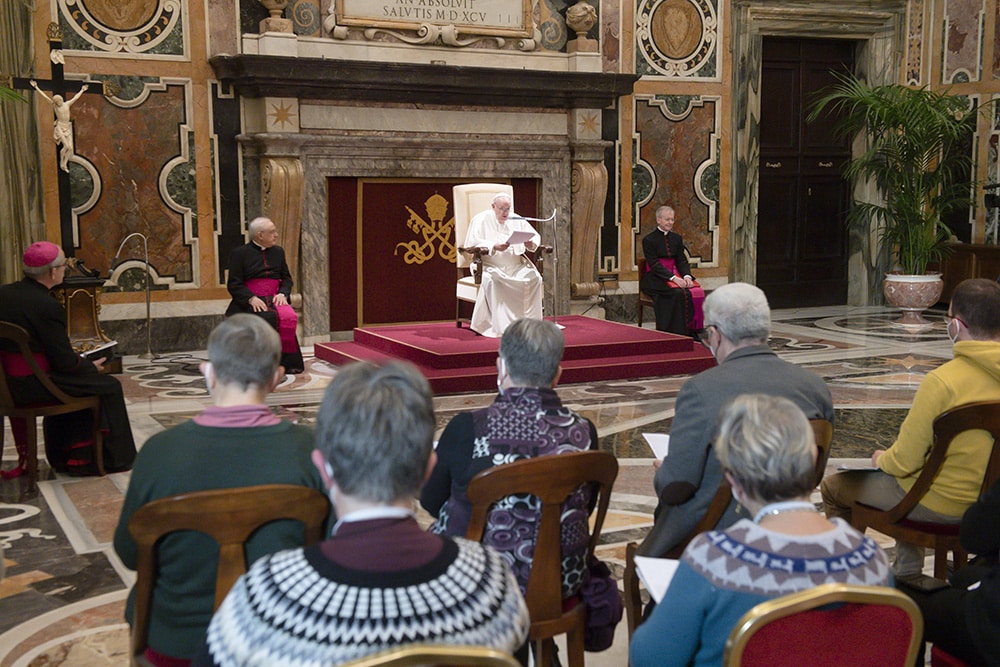The Catholic Church has a treasure chest that may be unknown to some people or rarely opened by others. The treasures inside are the many teaching documents written by the magisterium, the official teaching office of the Church that consists of the pope and/or the college of bishops in union with him. The documents explain and clarify divine revelation given to mankind via the life and ministry of Jesus, Sacred Scripture and Sacred Tradition. As Catholics, we believe Jesus established the teaching office as a way to communicate God’s word to the world until the end of time.
The teaching documents that bear the fruit of the magisterium’s reflection on divine revelation sometimes fall into obscurity after their initial release. In order to facilitate a rediscovery of these treasures, Our Sunday Visitor will provide an article on the meaning of one pivotal document per month for the next 14 months. Each of the articles will address four important components of the particular document being explained: 1.) the kind of document; 2.) the context; 3.) the content; and 4.) the call — or, in other words, what the document says to/expects of Church members.
The kind of document
The magisterium produces a number of documents that can be divided into two basic groups: legislative and explanatory. Legislative documents contain doctrinal or dogmatic elements that are binding on the whole Church. Doctrine refers to Church teaching in matters of faith and morals. Dogma includes those doctrines that the magisterium has defined formally as divinely revealed. Apostolic constitutions and papal decrees (as opposed to ordinary decrees), as well as the Catechism of the Catholic Church and the Code of Canon Law, are legislative documents. Apostolic constitutions carry the greatest level of authority because they define particular or universal laws concerning doctrinal or disciplinary matters.
Read more from our Church Documents series here.
Explanatory documents help Church members understand and put into practice existing law and doctrines, and they can be issued by the pope or a local bishop. Those issued by the pope apply universally to the Church and have greater authority than those issued by a bishop for a particular diocese. Four of the most common explanatory documents issued by the pope are listed here in order of greater to lesser authority (although, again, all of these merit close attention because of their origin in the papal office).
Encyclical: a formal letter from the pope that explains or clarifies existing doctrine.
Motu proprio: a letter from the pope that gives instruction on a particular matter or a new law issued at a certain moment in Church history.
Apostolic letter: a letter from the pope, pastoral in nature (not legislative or doctrinal), that gives counsel on a certain need or question in light of particular circumstances.
Apostolic exhortation: a papal reflection on a particular subject.
The pope by himself or with the magisterium publishes other documents as well: addresses that contain subjects unrelated to Church teaching or simple briefs that deal with minor matters. Knowing what kind of document one is reading helps to understand it better. (This series will examine five apostolic constitutions, seven encyclicals, and two apostolic exhortations. See the sidebar for a list of all 14 documents that this series will cover.)
Context
Since the Church has published documents throughout its more than 2,000 years of existence, it is very important to understand when a particular document was released. What are the major events, the popular movements, the important issues of the time period under consideration? And how did these historical elements impact the document?
For example, in the last 150 years, two apostolic constitutions about the Church have been published by the magisterium: Pastor Aeternus in 1870 and Lumen Gentium in 1964. Both of these will be the subjects of articles later in this series, but the reader should know that the Church took a defensive stance in 1870 because it felt under attack (e.g., Italy took over the papal states) versus a more conciliatory approach in 1964 when the Church felt the need to be more open to the world, and particularly to other Christians (there were great changes happening that the Church needed to address). Knowing the historical details helps to grasp what the Church was trying to teach via the particular document.
Another very important, but often overlooked, aspect of a document’s context is how it relates to the overall history of the Church. Consider Pastor Aeternus and Lumen Gentium again: They are separated by 96 years. It’s no surprise that the world had changed in the interim, and so they present different perspectives that readers should consider carefully. However, both documents also must be grounded in revelation. The magisterium is not charged with crafting new doctrines but with passing on the Faith first received by the apostles. Therefore, the context of every Church document includes not only its own moment in time but also its relationship to other documents and historical periods throughout the Church’s life.
Content
Just as the context of Church documents always involves divine revelation, the content does as well. Individual documents cover particular topics, of course, but they always relate to Jesus’ words and Scripture and Tradition. Divine revelation does not change; it has been perfectly revealed to us in the person of Christ. However, human beings do change, as do the times and culture, so the clarification of Church teaching is often needed in new circumstances.
The magisterium has the responsibility of discerning how revelation applies in new situations — a particular moment in history or an advance in scientific understanding. For example, the medical field has changed rapidly and dramatically over the years. Given what revelation tells us of the inherent dignity of the human person — each of whom has been made in the image and likeness of God — how should we approach life and death issues as followers of Christ? The encyclical Evangelium Vitae (1995) examines issues such as abortion, birth control and euthanasia in light of divine revelation and guides readers on how to respect and defend God’s gift of life. All of the teaching documents do the same for whatever topic under consideration. They strive to bring God’s revealed truth to bear on the life and times of the human community.
Call
The magisterium publishes documents for the people’s edification and decision-making. Members of the Church, like all people, make judgments about how to act in specific situations. The Church’s documents help individuals to make prayerful and thoughtful decisions that are steeped in the wisdom of the Church’s own 2,000-year-old reflection on revelation. People who avail themselves of these documents benefit from the magisterium’s discernment: What actions are good or evil? How does one come to that decision? The Church’s documents also help people avoid errors and understand the reasoning involved in a particular teaching.
The basic call of every Church document is to follow Jesus more closely. When the magisterium publishes a document, they are relying on the promises of Jesus to be with the Church always, “until the end of the age” (Mt 28:20), and to provide the Church with the wisdom of the Holy Spirit, who, Jesus says, “the Father will send in my name — he will teach you everything and remind you of all that I told you” (Jn 14:26).
The reason we can be confident in the official teaching of the Church is based on these promises of Jesus. It is the light of Christ that shines through the Church’s documents that make them an unfailing treasure and worthy of our close attention.
David Werning writes from Virginia.
| DOCUMENTS BEING COVERED |
|---|
|
Starting next month, here are the 14 Church documents that will be written about in this series:
View the documents in their entirety on the Vatican site here. |







